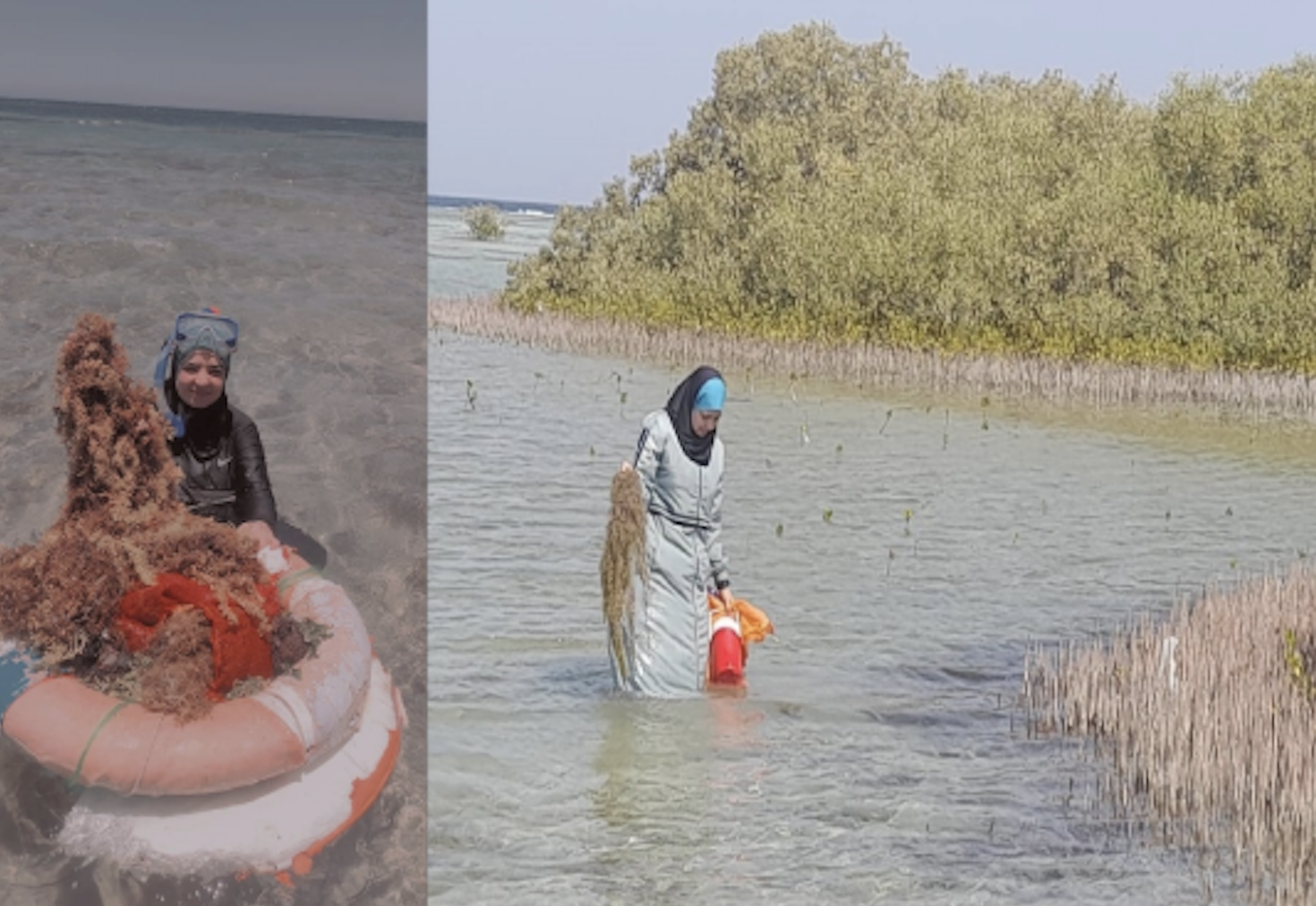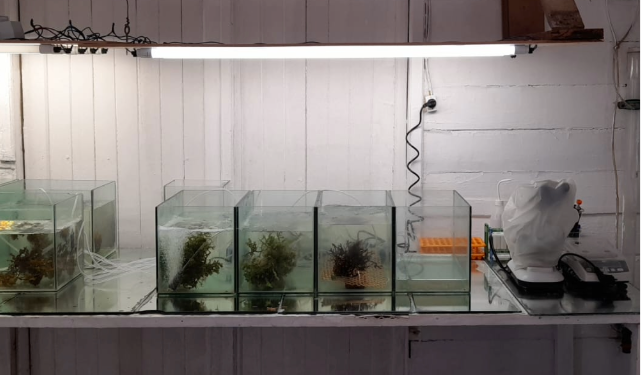Dr. Sarah Hamdy: Leading the Way in Seaweed and Algae Studies for a Sustainable Future – Seaweed is one of the most promising marine production of the Millennium, providing many environmental, social, and economic benefits. Actually, seaweed production has reached 35.8 million tons of cultivation, accounting for 97% of the world production of algae, with a global market of 11.8 billion US dollars. It is an excellent source of human food due to its low-fat content, high minerals, fiber, polyunsaturated fatty acids, sugars, vitamins, and biologically active compounds and is vital for the expansion of seaweed farming systems to provide aquatic foods and contribute globally to climate change mitigation and adaptation.
Dr Sarah Hamdy is a pioneer in seaweed production and has published numerous research papers and books in this field. There are many challenges faced by women in this sector, and Dr Sarah has been able to contribute to opening up new horizons for women to dive into the depths of the sea and reveal its hidden treasures.
Below are some of her declarations:
Briefly describe your career and current work
I am Sarah Hamdy Rashedy, a postdoctoral researcher at the National Institute of Oceanography and Fisheries (NIOF), Red Sea branch located in Hurghada, Egypt. My research focuses on the study of marine algae in the Red Sea, encompassing areas such as ecology, physiology, cultivation, and practical applications.
To date, I have authored 15 research papers published in international journals, with a focus on those classified in Q1 and Q2 categories. These papers cover a wide range of topics related to Red Sea algae, including their distribution along the coast, the extraction of bioactive compounds, and the assessment of their nutritional content, antioxidant properties, and antimicrobial effects.
Furthermore, I have contributed four chapters to various international books. These chapters delve into subjects such as the ecology and physiology of seaweeds, the conditions of ocean acidification, marine diatoms, and the biodiversity of seaweeds in the Red Sea. I have also engaged in international conferences, such as the 12th International Phycological Congress (IPC2021) held in Chile in 2020. Additionally, I recently took part in a training course on seaweed cultivation and biotechnology held in Tunisia in 2023.
Google Scholar link:
https://scholar.google.com.eg/citations?hl=en&user=BglUXn0AAAAJ
A focus on the relevance of marine algae
Seaweeds (macroalgae) are a group of photosynthesizing organisms that are attached to the rock or another hard substrate in coastal areas. Ecologically, many species provide protective habitats for a wide range of flora and fauna preserve the coastal community, and act as the primary producers and carbon sinks. Seaweeds have been classified into three groups based on pigment brown (Phaeophyta), red (Rhodophyta), and green (Chlorophyta) types.
Seaweeds are economically valuable resources and could be used as:
1. Food: In many countries like Japan, Malaysia, Indonesia, Korea, and Australia seaweeds are used for human consumption. These are used in preparing salads, soups, jellies, and vinegar. Some seaweeds are rich in vitamin B such as Gracilaria sp., Laurencia sp., Caulerpa sp., and Sargassum sp.
2. Feed: Some seaweed species are used in cattle feed such as Ulva sp., Enteromorpha sp., Gracilaria sp., Padina sp., and Sargassum sp. Also, some important seaweed species are mixed with fish waste and used in poultry and aquaculture feeding.
3. Fertilizer: Seaweeds have a unique capacity to bioaccumulate trace elements from ambient water and, therefore they are rich sources of macro- and micro-elements required for the growth of plants.
4. Medicine: Seaweeds have wide applications in the sphere of medicine. Sargassum sp. and Turbinaria sp. are good sources of alginates, which are known to prolong the period of activity of certain drugs.
5. As industrial raw material: Agar-agar is a gelatinous colloidal carbohydrate present in the cell wall of algae and is extracted from some members of Rhodophyceae. Algin and alginates have extensive uses in the preparation of various medicines, cosmetics, paper products, textile products, paints, milk products, etc.
6. Biological treatment: Seaweeds can also be used for the biological treatment of industrial wastewater.
An overview of the seaweed farming in Egypt
Despite Egypt having both the Red Sea and the Mediterranean Sea, each hosting a diversity of seaweeds, no seaweed cultivation has been attempted in the country so far. Therefore, I am diligently working on seaweed cultivation through my research. We are currently in the experimental application phase, conducting trials on economically viable species to implement seaweed farming in the sea.
Some consideration on the extraction of some important components from red sea algae
The most important components extracted from the Red Sea algae include polysaccharides, especially alginate. Alginates are one of the most important compounds of the brown seaweeds. They are broadly applied in food areas, because of their important characteristic, such as viscosity gelling, stabilizing features, and as a dietary fiber source. Through our research, five species of the dominant brown seaweeds were collected in the Red Sea (Padina boergesenii, Turbinaria triquetra, Hormophysa cuneiformis, Dictyota ciliolata, and Sargassum aquifolium) to characterize the alginate yield and to evaluate the alginate physicochemical and phytochemical properties. The alginate yield demonstrates the potential application of the studied seaweeds as a nutraceutical raw source that can be further exploited by the food industry.
The link to the research thorough: https://doi.org/10.3390/app11146290

The difficulties you have encountered
One of the challenges I initially faced was the limited experience in seaweed cultivation in Egypt. This prompted me to seek training abroad. I underwent training in Tunisia with a Tahaleb project and attended online courses. In addition, there was also a lack of resources available for establishing a specialized project in this field.
Your advice for women and the new generation in starting a career in the marine algae farming sector
My advice for women and the new generation looking to start a career in the field of marine algae cultivation is:
- Acquire Knowledge and Learn: Start by gaining a deep understanding of the basics of marine algae and their cultivation. Conduct research, read extensively, and study the subject to grasp how algae grow and the key factors that influence successful cultivation.
- Practical Training and Hands-On Experience: Seek opportunities for practical training and hands-on experience in algae cultivation. Look for internships, workshops, or projects where you can apply your knowledge in real-world settings.
- Build a Network: Connect with professionals and experts in the field of marine algae cultivation. Building a strong network can provide valuable insights, mentorship, and collaboration opportunities.
- Embrace Sustainability: Pay attention to sustainable practices in algae cultivation. It’s crucial to consider environmental impact and adopt eco-friendly methods in your work.
- Market Research: Study the market and its demands. Is there a demand for marine algae products? How can you meet this demand? Understanding market trends and consumer needs is essential for success.
- Persistence and Resilience: Algae cultivation can be challenging, so cultivate persistence and resilience. Be prepared to face setbacks and learn from them to improve your techniques.
- Innovation: Explore innovative approaches and technologies in algae cultivation. Stay updated on the latest developments in the field to remain competitive and adaptable.
- Believe in Yourself: Have confidence in your abilities and believe in your potential to make a meaningful contribution to the field of marine algae cultivation.

Dr. Sarah Hamdy: Leading the Way in Seaweed and Algae Studies for a Sustainable Future








